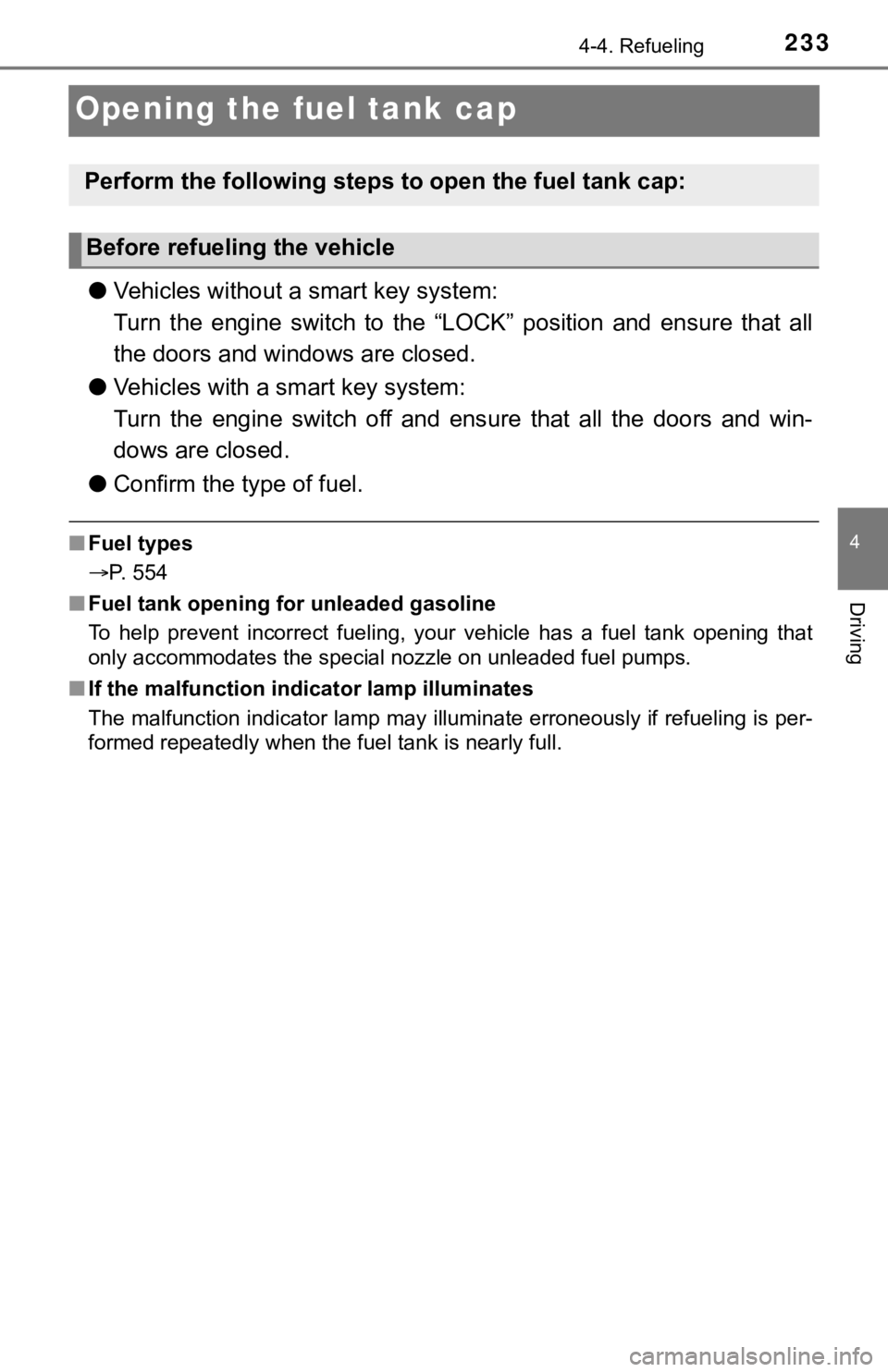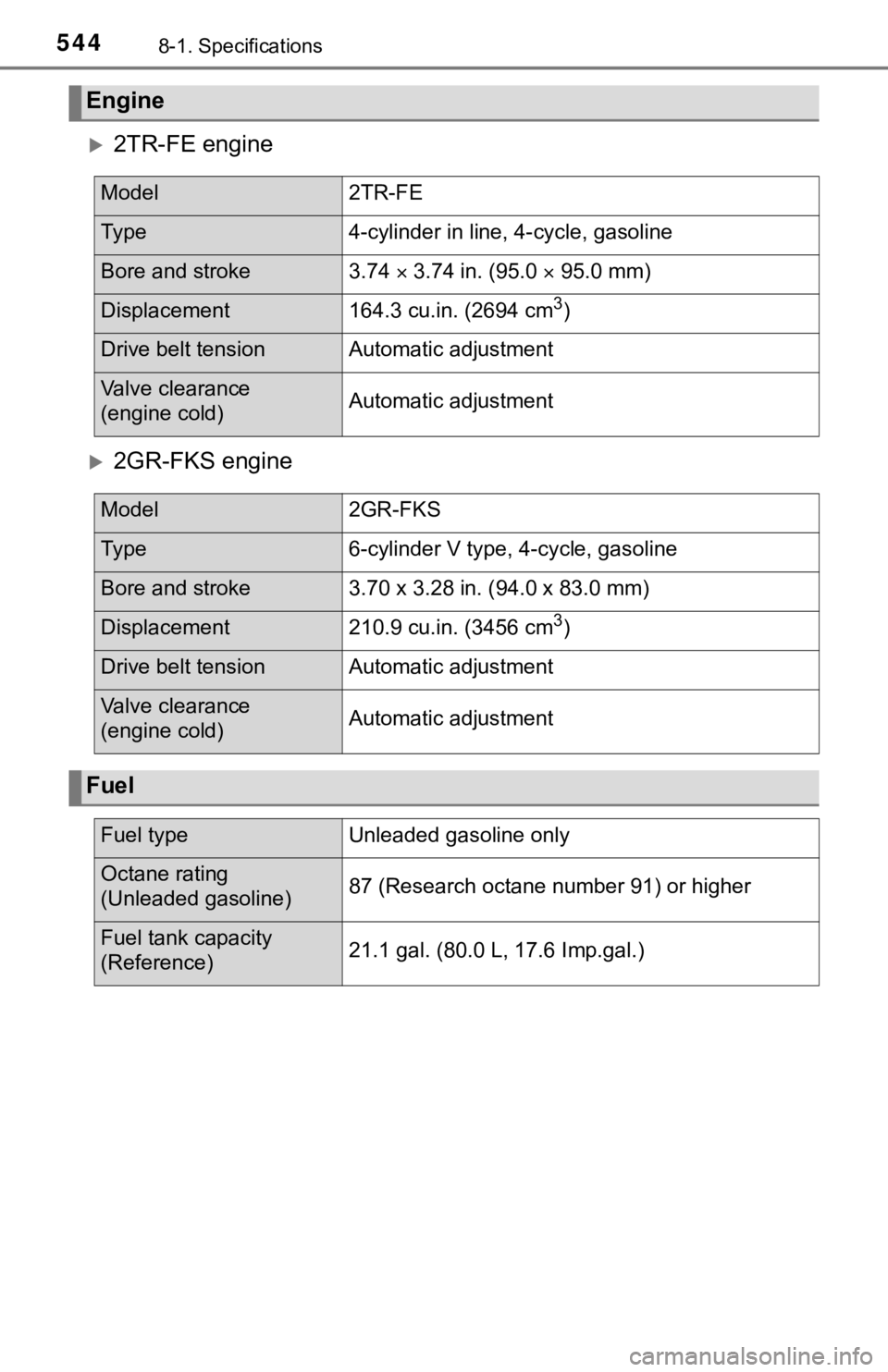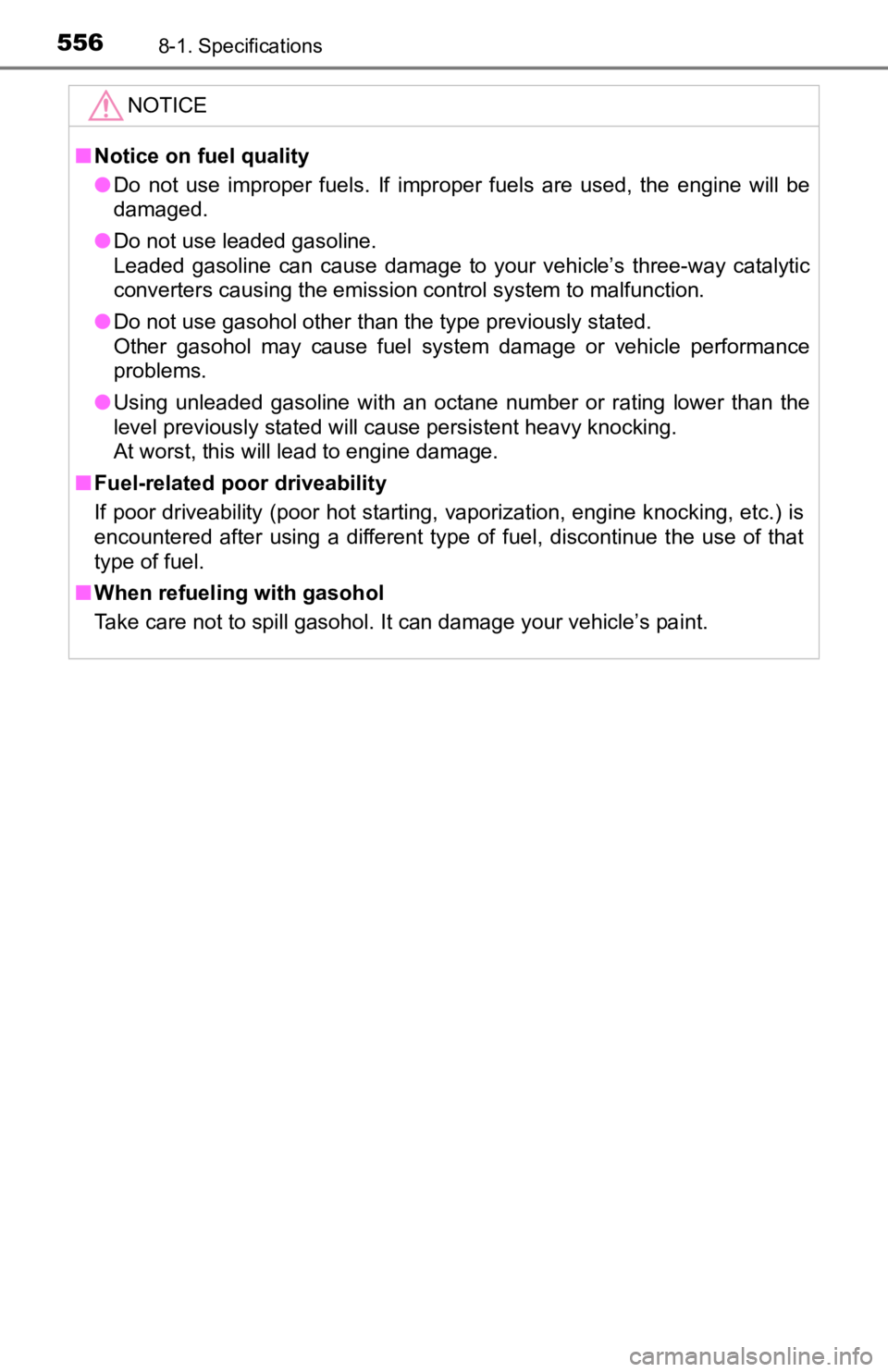2023 TOYOTA TACOMA fuel type
[x] Cancel search: fuel typePage 2 of 616

TABLE OF CONTENTS2
For your information....................... 8
Reading this manual .................... 14
How to search .............................. 15
Pictorial index .............................. 16
1-1. For safe useBefore driving ...................... 26
For safe driving ................... 28
Seat belts ............................ 30
SRS airbags ........................ 36
Front passenger occupant classification system ......... 48
Safety information for children ........................ 53
Child restraint systems ........ 54
Installing child restraints ...... 58
Exhaust gas precautions ..... 71
1-2. Emergency assistance Safety Connect.................... 72
1-3. Theft deterrent system Engine immobilizer system............................... 78
Alarm ................................... 88
2. Instrument cluster Warning lights and indicators........................... 92
Gauges and meters............. 98
Multi-information display ... 102
Fuel consumption information ...................... 109 3-1. Key information
Keys................................... 112
3-2. Opening, closing and locking the doors
Doors ................................. 119
Tailgate .............................. 126
Smart key system .............. 131
3-3. Adjusting the seats Front seats......................... 139
Rear seats ......................... 142
Head restraints .................. 145
3-4. Adjusting the steering wheel and mirrors
Steering wheel ................... 149
Inside rear view mirror ....... 151
Outside rear view mirrors ............................. 154
3-5. Opening, closing the windows and moon roof
Power windows.................. 156
Back window (vehicles with sliding type) .............. 159
Power back window ........... 160
Moon roof .......................... 162
1For safety and security
2Instrument cluster
3Operation of
each component
Page 17 of 616

17Pictorial index
Fuel filler door . . . . . . . . . . . . . . . . . . . . . . . . . . . . . . . . . . . . P. 233
Refueling method . . . . . . . . . . . . . . . . . . . . . . . . . . . . . . . . . . . P. 233
Fuel type/fuel tank capacity . . . . . . . . . . . . . . . . . . . . . . . . . . . P. 544
Tires . . . . . . . . . . . . . . . . . . . . . . . . . . . . . . . . . . . . . . . . . . . . P. 431
Tire size/inflation pressure . . . . . . . . . . . . . . . . . . . . . . . . . . . . P. 551
Winter tires/tire chain . . . . . . . . . . . . . . . . . . . . . . . . . . . . . . . . P. 329
Checking/rotation/tire pressure warning system
*3 . . . . . . . . . P. 431
Coping with flat tires . . . . . . . . . . . . . . . . . . . . . . . . . . . . . . . . P. 511
Hood . . . . . . . . . . . . . . . . . . . . . . . . . . . . . . . . . . . . . . . . . . . . P. 417
Opening . . . . . . . . . . . . . . . . . . . . . . . . . . . . . . . . . . . . . . . . . . P. 417
Engine oil . . . . . . . . . . . . . . . . . . . . . . . . . . . . . . . . . . . . . . . . . P. 545
Coping with overheat . . . . . . . . . . . . . . . . . . . . . . . . . . . . . . . . P. 534
Camera
*2
Headlights . . . . . . . . . . . . . . . . . . . . . . . . . . . . . . . . . . . . . . . P. 220
Fog lights
*3 . . . . . . . . . . . . . . . . . . . . . . . . . . . . . . . . . . . . . . P. 229
Front turn signal lights . . . . . . . . . . . . . . . . . . . . . . . . . . . . . P. 218
Parking lights (bulb type)
*3/
daytime running lig hts (bulb type)
*3. . . . . . . . . . . . . . . . . . P. 220
Parking lights (LED type)
*3/
daytime running lights (LED type)
*3 . . . . . . . . . . . . . . . . . . P. 220
Rear turn signal/tail lights . . . . . . . . . . . . . . . . . . . . . . . . . . . P. 218
Stop/tail lights . . . . . . . . . . . . . . . . . . . . . . . . . . . . . . . . . . . . P. 220
Hill-start assist control
*3 . . . . . . . . . . . . . . . . . . . . . . . . . . . . . P. 3 24
License plate lights . . . . . . . . . . . . . . . . . . . . . . . . . . . . . . . . P. 220
Back-up lights
Shifting the shift lever to R . . . . . . . . . . . . . . . . . . . . . . . . P. 211, 216
Side marker lights . . . . . . . . . . . . . . . . . . . . . . . . . . . . . . . . . P. 220
6
7
8
9
Light bulbs of the exter ior lights for driving
(Replacing method: P. 458, Watts: P. 553)
*1: Vehicles with a smart key system
*2: Refer to “NAVIGATION AND MULTIMEDIA SYSTEM OWNER’S MANUAL”
*3: If equipped
10
11
12
13
14
15
16
17
18
Page 222 of 616

2224-3. Operating the lights and wipers
With the headlights on, push
the lever away from you to turn
on the high beams.
Pull the lever toward you to the
center position to turn the high
beams off.
Pull the lever toward you and
release it to flash the high
beams once.
You can flash the high beams with the headlights on or off.
■Daytime running light system
●The daytime running lights illuminate using the same lights as the front turn
signal/parking lights, and illuminate brighter than the front t urn signal/park-
ing lights.
● To make your vehicle more visible to other drivers during dayti me driving,
the daytime running lights turn on automatically when all of the following
conditions are met. (The daytime running lights are not designe d for use at
night.)
• The engine is running
• The parking brake is released
• The headlights switch is in “AUTO”* (type A and C) or the “DRL ” (type B)
position
*: When the surroundings are bright
The daytime running lights remain on after they illuminate, even if the parking
brake is set again.
● Compared to turning on the headlights, the daytime running ligh t system
offers greater durability and consumes less electricity, so it can help improve
fuel economy.
■ Headlight control sensor (vehicl es with an automatic light control sys-
tem)
Turning on the high beam headlights
1
2
The sensor may not function properly if an
object is placed on the sensor, or anything
that blocks the sensor is affixed to the
windshield.
Doing so interferes with the sensor
detecting the level of ambient light and
may cause the automatic headlight sys-
tem to malfunction.
Page 233 of 616

2334-4. Refueling
4
Driving
Opening the fuel tank cap
●Vehicles without a smart key system:
Turn the engine switch to the “LOCK” position and ensure that a ll
the doors and wind ows are closed.
● Vehicles with a smart key system:
Turn the engine switch off and ens ure that all the doors and win-
dows are closed.
● Confirm the type of fuel.
■Fuel types
P. 554
■ Fuel tank opening for unleaded gasoline
To help prevent incorrect fueling, your vehicle has a fuel tank opening that
only accommodates the special nozzle on unleaded fuel pumps.
■ If the malfunction indicator lamp illuminates
The malfunction indicator lamp may illuminate erroneously if re fueling is per-
formed repeatedly when the fuel tank is nearly full.
Perform the following steps to open the fuel tank cap:
Before refueling the vehicle
Page 540 of 616

5408-1. Specifications
Maintenance data (fuel, oil level, etc.)
*1: Unladen vehicle
*2: P265/60R18 tires
*3: Vehicles with a over fender
■
TWR (Trailer Weight Rating)
P. 1 8 7
Dimensions
Cab type Access Cab
Overall length212.3 in. (5392.3 mm)
Overall width 74.4 in. (1890.5 mm)
Overall height*170.6 in. (1792.2 mm)
Wheelbase127.8 in. (3247 mm)
Front tread63.0 in. (1599 mm)
63.3 in. (1609 mm)*2
Rear tread63.2 in. (1606 mm)
63.6 in. (1616 mm)*2
Cab typeDouble Cab
With short deck With long deck
Overall length
212.3 in. (5392.3 mm) 225.5 in. (5727.3 mm)
Overall width74.4 in. (1890.5 mm)
75.2 in. (1910.3 mm)*3
Overall height*170.6 in. (1792.2 mm)
Wheelbase
127.8 in. (3247 mm) 141.0 in. (3582 mm)
Front tread63.0 in. (1599 mm)
63.3 in. (1609 mm)*2
Rear tread63.2 in. (1606 mm)
63.6 in. (1616 mm)*2
Page 544 of 616

5448-1. Specifications
2TR-FE engine
2GR-FKS engine
Engine
Model2TR-FE
Ty p e4-cylinder in line, 4-cycle, gasoline
Bore and stroke3.74 3.74 in. (95.0 95.0 mm)
Displacement164.3 cu.in. (2694 cm3)
Drive belt tensionAutomatic adjustment
Valve clearance
(engine cold)Automatic adjustment
Model2GR-FKS
Ty p e6-cylinder V type, 4-cycle, gasoline
Bore and stroke3.70 x 3.28 in. (94.0 x 83.0 mm)
Displacement210.9 cu.in. (3456 cm3)
Drive belt tensionAutomatic adjustment
Valve clearance
(engine cold)Automatic adjustment
Fuel
Fuel typeUnleaded gasoline only
Octane rating
(Unleaded gasoline)87 (Research octane number 91) or higher
Fuel tank capacity
(Reference)21.1 gal. (80.0 L, 17.6 Imp.gal.)
Page 549 of 616

5498-1. Specifications
8
Vehicle specifications
*: The fluid capacity is the quantity of reference.If replacement is necessary, contact your Toyota dealer.
Automatic transmission
Fluid
capacity
*
2TR-FE engine 9.2 qt. (8.7 L, 7.7 Imp.qt.)
2GR-FKS engine 10.6 qt. (10.0 L, 8.8 Imp.qt.)
Fluid type Toyota Genuine ATF WS
NOTICE
■Transmission fluid type
Using transmission fluid other than the above type may cause abnormal
noise or vibration, or damage the transmission of your vehicle.
Manual transmission
Gear oil capacity (Reference) 2.6 qt. (2.5 L, 2.2 Imp.qt.)
Gear oil type Toyota Genuine Manual Transmission
Gear Oil GL-3 (GL-4) or equivalent
Recommended gear oil viscosity SAE 75W-90
NOTICE
■
Manual transmission gear oil
Please be aware that depending on the particular characteristics of the gear
oil used or the operating conditions, idle sound, shift feeling and/or fuel effi-
ciency may be different or affected. Toyota recommends to use “ T O Y O TA
Genuine Manual Transmission Gear Oil” to achieve optimal perfor mance.
Cluch
Clutch free play0.2 — 0.6 in. (5 — 15 mm)
Fluid typeFMVSS No. 116 DOT 3 or SAE J1703
Page 556 of 616

5568-1. Specifications
NOTICE
■Notice on fuel quality
● Do not use improper fuels. If improper fuels are used, the engi ne will be
damaged.
● Do not use leaded gasoline.
Leaded gasoline can cause damage to your vehicle’s three-way catalytic
converters causing the emission control system to malfunction.
● Do not use gasohol other than the type previously stated.
Other gasohol may cause fuel system damage or vehicle performance
problems.
● Using unleaded gasoline with an octane number or rating lower than the
level previously stated will cause persistent heavy knocking.
At worst, this will lead to engine damage.
■ Fuel-related poor driveability
If poor driveability (poor hot starting, vaporization, engine k nocking, etc.) is
encountered after using a different type of fuel, discontinue the use of that
type of fuel.
■ When refueling with gasohol
Take care not to spill gasohol. It can damage your vehicle’s paint.